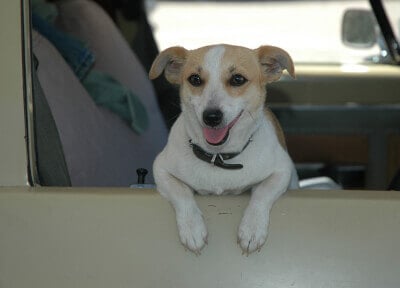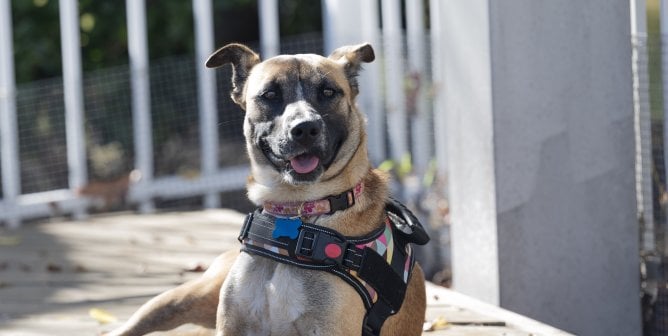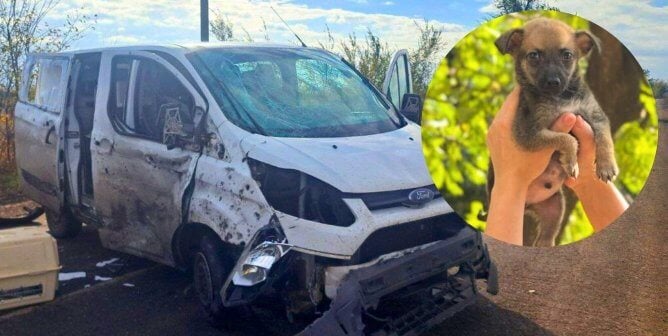Driving is less risky for companion animals than flying is. Some major hotel chains have changed their attitudes toward animals and are welcoming them now; the American Automobile Association (AAA) says that the number of lodgings accepting companion animals in the United States surpasses 12,000. One Marriot hotel general manager said, “I’ve never had a dog destroy a hotel room. I’ve had 100 people destroy a hotel room.”
The following tips will help make your journey in the car safer:
- Carry water for rest stops. No-spill travel bowls are available in pet supply stores and catalogs.
- For dogs prone to carsickness, consult your veterinarian for remedies or try ginger capsules, available at health-food stores.
- Cats can turn into escape artists on the road, so keep them in sturdy, well-ventilated carriers that are big enough for them to stand up and turn around in comfortably. Line the carrier with a towel and a tiny litter tray, and secure the carrier to the seat with a seat belt.
- Dogs are safest in a kennel or restrained with a canine seat belt, available from catalogs, pet supply stores, and online retailers such as FurHaven.
- Don’t carry your animal in a box or carrier made of cardboard—it will provide almost no protection in an accident.
- Never open a car window or door when your cat or dog is unrestrained. Countless dogs and cats have been lost at tollbooths and rest stops this way.
- Stop to walk dogs often.
Warning: Please be aware of the dangers to animals who are left in hot cars.
Extra Tips to Keep Kitty Safe in the Car
Most cats regard even slow-moving vehicles in much the same way that claustrophobics view closets. Even the horn scares them. A lot of this can probably be attributed to the fact that the only time most cats see the inside of a car is when their next sight will be the veterinarian’s office. Cars mean that something unpleasant is getting even closer. Some cats were introduced to car rides for pure fun in their kittenhood and seem to actually enjoy them. This does not alter the fact that cats and cars are generally a bad mix.
For example, if a vehicle backfires, a gun-shy dog may cower, but a cat may flee (in some strange territory, chances of recovery are slim). George, one of the most dearly loved cats ever to grace a household, was lost in this way.
Cars also have windows and seats. Although it may be impossible for a wolfhound or even a corgi to clamber out through a tiny crack in the window that lets the driver pay a gas station attendant or a toll, most cats can squeeze their way out of a toothpaste tube. As for seats, we have never heard of a dog getting caught in the springs under a seat or having to be cut out of the metalwork over the wheelbase, but both things frequently happen to cats. Extricating them wastes a chunk of a person’s life and sometimes a chunk out of the car. The cat may emerge physically intact but can suffer emotional scars that may never heal.
If you are going to travel by car with your cat, here’s how to do it right:
1. Always use a sturdy carrier. Double-check that the carrier door is absolutely secure. Never let your cat loose in the car. Countless cats have been lost at tollbooths and rest stops this way.
2. Keep the carrier from wobbling by creating as flat an area as possible for it to sit on (pack a towel around the outside if you need to). Do not let kitty see that you are headed for the car—drape a breathable cloth over the carrier before heading out the door, place the carrier on the flat space in the car, then rearrange the cloth so that your cat can see you, if possible, but not out any window. The sight of the earth or sky speeding past causes most cats to panic, begin open-mouthed breathing, and howl miserably.
3. Pad the inside of the carrier with something comfy, such as a towel, to make travel easier and less bumpy.
4. Play the radio softly to drown out traffic noises (try a soothing classical music station).
5. Talk to your cat as you go. If he or she complains, always answer reassuringly.
6. Make the ride as smooth as possible. Avoid lurching forward, brake smoothly, and imagine that you are delivering crystal glassware that will shatter if you do not look ahead and steer clear of bumps and potholes in the road.
7. When you arrive at your destination, let kitty scope out the new indoor setting from the sanctity of the carrier; then offer food, water, and litter outside it. In strange surroundings, ensure that all doors and windows are shut as tight as can be before the kitty emerges from the carrier.








